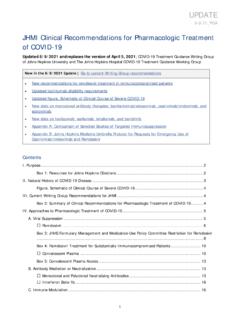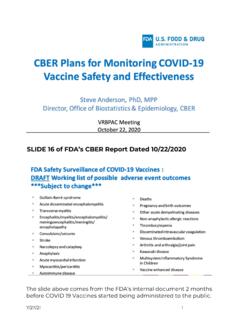Transcription of PATHOPHYSIOLOGY OF PARKINSON’S DISEASE
1 123 PATHOPHYSIOLOGYOFPARKINSON s DISEASE (PD) is thought to affect more than 1million people in the United States alone, 1 of every 100individuals above the age of 55. In the two centuries sinceit was first described by James parkinson , we have learned agreat deal about the disorder. We have, for example, learnedwhere the primary lesion is and what many of the clinicalmanifestations are. However, it has only been in the pastfew decades that insights have begun to emerge regardingthe cause of the DISEASE , and only now can one begin to seethe possibilities of treatments emerging that will providemore than temporary symptomatic relief.
2 Beginning withthe Nobel Prize winning work of Arvid Carlsson, whichpointed to the loss of dopamine (DA) as the principal deficitin PD and to levodopa as a mode of pharmacotherapy, wehave come to understand what fails in this disorder and,more recently, how we might correct that failure. Moreover,although parkinson focused entirely on motor symptoms,we have come to realize that the disorder is much morecomplex and includes a panoply of psychiatric symptomsas clinical features, course, and treatment of PD arepresented in detail in Chapters 122 and 124; thus, for thepurposes of this review of etiology and pathogenesis, weonly briefly highlight the more important aspects of thesetopics, including those of a psychiatric nature.
3 We thendescribe the pathology before turning to several promisingleads with regard to the underlying etiology of the SIGNS AND SYMPTOMSM otor ManifestationsPD is a chronic, progressive neurologic DISEASE . It presentswith four cardinal motor manifestations: tremor at rest, :Departments of Neurology and Psychiatry, Univer-sity of Pittsburgh, Pittsburgh, :Department of Neurology, Columbia University, NewYork, New , bradykinesia (or slowing of movement), and posturalinstability. Not all patients initially present with all of theclassic signs of the disorder; there may be only one or , the first complaint is one of motor weakness or stiff-ness, and the cause is commonly misdiagnosed.
4 However,postural deficits and tremor may soon emerge, promptinga reconsideration of the basis of the problem. It is importantto note, however, that the clinical diagnosis of PD is madeon the basis of a medical history and neurologic examina-tion; there is currently no laboratory test that can definitelyestablish a diagnosis. Even neuroimaging, which can be usedto obtain an estimate of DA loss (15,128), is imperfect andin any event is too expensive to be used as a routine diagnos-tic tool. As a result, it has been estimated that a significantnumber of individuals diagnosed as having PD fail to showthe histopathologic hallmarks of the DISEASE upon autopsy(48,70,134).
5 Atremorat rest is one of the most characteristic featuresof the DISEASE , occurring in 70% of patients (68). Whereasit is not required for diagnosis, the prolonged absence oftremor in the course of a patient s illness should lead to thecareful consideration of other neurologic conditions thatcan present with signs of parkinsonism, including the multi-ple system atrophies, progressive supranuclear palsy, corti-cobasal ganglionic degeneration, and others (94).Rigidityis a motor sign more often appreciated by the examiningphysician than the patient; it is detected as a resistance topassive movement of the limbs.
6 It is often uniform in direc-tions of flexion and extension ( lead pipe rigidity ), butthere may be a superimposed ratcheting ( cogwheel rigid-ity ).Bradykinesiarefers to a slowness and paucity of move-ment; examples include loss of facial expression, which maybe misinterpreted as a loss of affect, and associated move-ments such as arm swinging when walking. Bradykinesia isnot due to limb rigidity; it can be observed in the absenceof rigidity during treatment. When bradykinesia affects theoropharynx, it can lead to difficulties in swallowing, whichin turn may cause aspiration pneumonia, a potentially life-threatening complication.
7 Of the cardinal motor signs,pos-Neuropsychopharmacology: The Fifth Generation of Progress1782tural instabilityis the most potentially dangerous, becauseit can lead to falls with resulting fractures. It is also one of themanifestations that responds less well to levodopa may also be less responsive, even early in the course(95).An additional motor feature of PD is the freezing phe-nomenon, also referred to as motor block (51). In itsmost typical form, freezing occurs as a sudden inability tostep forward while walking. It may occur at the beginning( start hesitation ), at a turn, or just before reaching thedestination.
8 It is transient, lasting seconds or minutes, andsuddenly abates. Combined with postural instability, it canbe devastating. Freezing does not always improve with levo-dopa, and, in fact, can be made and Psychiatric ManifestationsIt is increasingly clear that there are many parallel circuitswithin the basal ganglia, each subserving a different functionand each modulated by DA (see Chapter 122). Thus, it isreasonable to predict that patients will have a wide varietyof dysfunctions extending well beyond the classic motordisabilities associated with the DISEASE . Indeed, patients withParkinson s DISEASE appear to be at increased risk for a varietyof cognitive and psychiatric dysfunctions.
9 Most common isdementia and depression. However, hallucinations, delu-sions, irritability, apathy, and anxiety also have been re-ported (1). Here we will comment on the most prevalentof these now recognized as one of the cardinal non-motor manifestations of PD. It is a major cause of disability,and, unlike the motor manifestations, there currently is noeffective symptomatic treatment. Aarsland and co-workers(2) identified in dementia in 28% of PD patients. The prev-alence depends on age; in a study of PD patients over theage of 8 5by Mayeux et al. (108), 6 5% were patients with dementia show a more rapidly progressivecourse (110), and are more likely to be institutionalized,than nondemented individuals (2).
10 Years ago, there was debate about whetherdepressionisa primary manifestation of PD or a reaction to having achronic neurologic illness. There is now little question thatit is a primary manifestation. Mayeux and colleagues (109a)have found that 47% of PD patients show evidence ofdepression, and some have found an even higher incidence(147). Moreover, Aarsland and colleagues (2) report thatmajor depression is much more common among PD pa-tients who also have signs of dementia (22%) than thosewho did not (2%). The depression, however, is not relatedto the severity of motor signs; indeed, many patients aredepressed prior to the onset of frank neurologic , the depression is often greater than that seen inindividuals with comparably debilitating motor dysfunctiondue to other has long been suggested that patients with PD canhave particular premorbidpersonality traits(126,129,152).




